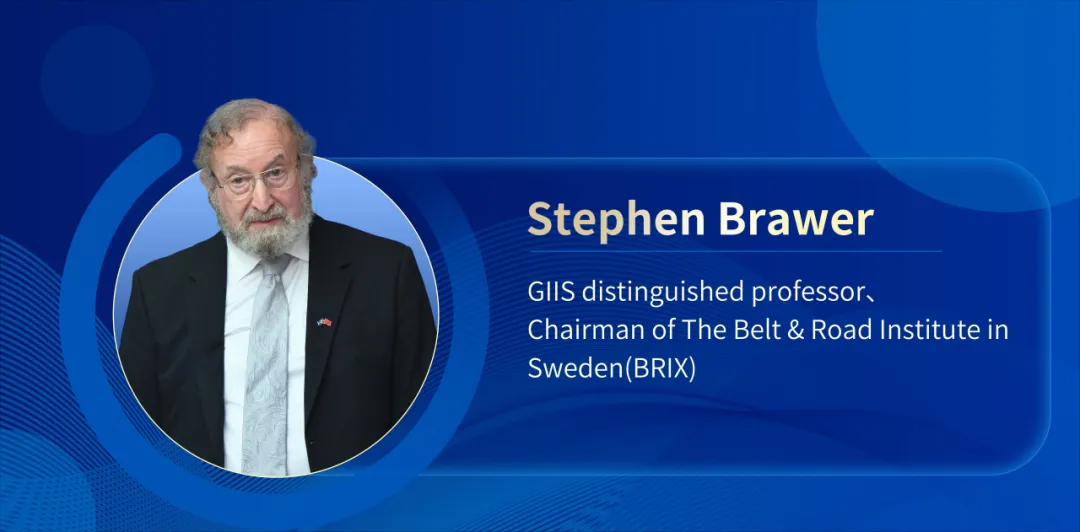导读
“年轻人,向西走吧!” 是 19 世纪美国经济增长和发展的口号,修建横贯大陆的铁路以促进发展也是亚伯拉罕·林肯的愿景。如今,中国“一带一路”倡议也展现了同样的进步和发展精神。就此,我院特聘研究员、瑞典“一带一路”研究所所长史蒂芬·布劳尔(Stephen Brawer)在《北欧时报》发表文章《A new decade for the BRI: Xinjiang – Gateway to the future》。
文章通过描述他的新疆之旅,回击了西方对中国的抨击,并强调了新疆作为东西方的桥梁,在“一带一路”中发挥的重要作用。他认为,新疆是“一带一路”倡议迈向新时期的未来之门,只有增进理解和认识,团结人类文明,我们才能实现“人类命运共同体”的目标。
以下为原文转载。

A new decade for the BRI: Xinjiang – Gateway to the future
My visit to Xinjiang in November 2023 was the opportunity of a lifetime. Since I became chairman of the Belt and Road Institute in Sweden, the mainstream media in Sweden and Europe has been pouring out false information, attacking China for “human rights” abuses, forced labor camps, and even genocide against the Uyghurs in Xinjiang. This disinformation campaign is directed mainly toward the European population and has worked only because they lack the experience and the ability to see the reality for themselves. I am very happy and very privileged to have been given this opportunity personally. Xinjiang is a province in the far west of China. Although it is the province with the largest land area, it is also one of the least populated provinces with a total population of approximately 25 million.
The landscape is among the most beautiful I have seen in my lifetime. The seemingly unending sands of the Taklamakan desert and the snow-covered peaks of the Tian Shan mountains combine for an unforgettable experience of the power of Nature.
Xinjiang literally means “New Frontier” in Chinese. Since China embraced the policy reforms of Deng Xiaoping’s “Opening Up” in 1978, China’s rapid development transformed the Guangdong province. The city of Shenzhen has been particularly successful in implementing Deng’s policies, growing from a small fishing village into a high-tech metropolis of more than 20 million people. Shenzhen is now, in fact, the model for how to replicate this great success in Xinjiang.
Xinjiang literally means “New Frontier” in Chinese.
My visit included a trip to Kashgar.I was an invited speaker at a major conference on the Belt and Road Initiative held at Kashgar University. The expansion and development of the University as a major source of knowledge and higher education was by itself an inspiring experience. In his speech in Beijing on the 10th anniversary of the Belt and Road Initiative in October 2023, Chinese President Xi Jinping focused on the next 10 years for the further development of the Belt and Road Initiative. My presence at the Belt and Road Forum, made clear to me China’s commitment to Xinjiang, in the Belt and Road Initiative (BRI).
Xinjiang borders eight countries, all of which can and will play a central role in connecting China to Central Asia and Europe. Major infrastructure, industrial, energy and trade corridors are being built to connect Xinjiang with these countries. These neighbouring countries are Kazakhstan, Russia, India, Kyrgyzstan, Tajikistan, Pakistan, Mongolia, and Afghanistan.
There can in the not-so-distant future be a network of fast trains running between China and these bordering countries through Xinjiang. Ürümqi has already become a logistics hub with 6 500 freight trains carrying goods manufactured in Xinjiang to 19 countries in Europe and Central Asia. China is receiving large portions of its gas pipeline imports from Central Asia.
The potential of natural gas reserves as well as hydro power development is a natural organic connection between Xinjiang and China, into Central Asia, and further into Southwest Asia, Africa, and Europe. Not to join in such a grand development perspective which the BRI envisions is worse than short-sighted. It is in fact sabotage of mankind’s best interests.
Ürümqi has already become a logistics hub with 6500 freight trains carrying goods manufactured in Xinjiang to 19 countries in Europe and Central Asia.
It was in 2004, that the Chinese governmentlaunched its “Go West” campaign. The purpose was to balance the economic growth of China’s wealthier and more populous eastern provinces with the less developed and more sparsely populated western regions. The BRI, which was an extension of this “Go West” strategy, has expanded China’s “Opening Up”, to include the vast landmass of Eurasia. During my visit to Shenzhen, I was able to visit the historical museum, which describes the great transformation which was led by Yuan Geng. It was inspiring to see how Shenzhen was transformed into what is today one of the main drivers of China’s economic growth. The vision of Xinjiang becoming a new Shenzhen was an underlying theme of the conference at Kashgar. The coming ten years of the BRI have all the potential to turn Xinjiang into the gateway of prosperity in Central and West Asia.
Ironically, the internal development of the United States was based on precisely the same type of vision. “Go West, Young Man!” was the 19th century rallying cry for economic growth and development in the United States. It was also Abraham Lincoln’s vision to build the transcontinental railroad to facilitate this development. If only there were leaders, like Lincoln, in the United States today, that would operate and think in similar ways, there would be no problem in bringing the United States and Europe on board to join and cooperate with the BRI.
“Go West, Young Man!” was the 19th century rallying cry for economic growth and development in the United States.
Xi Jinping’s Global Civilization Initiative is a framework for uniting human civilization around cultural dialogue. In light of this, the religious, cultural and historical archive of Xinjiang can impact not only Eurasia, but most importantly Western civilization. It addressess the need to build bridges between East and West. Only by improving understanding and knowledge which ultimately unites human civilizations can we achieve the goal of “a community for a shared future for mankind”.
Only by improving understanding and knowledge which ultimately unites human civilizations can we achieve the goal of “a community for a shared future for mankind”.
Let us proceed in light of these higher ideals of human reason. It is with this goal in mind that the work of the Belt and Road Institute in Sweden will go forward and grow.
Stephen Brawer,
Chairman of BRIX Sweden – The Belt and Road Institute in Sweden
BRIX Sweden
The Belt and Road Institute in Sweden, is a non-profit association founded by the organizers, speakers and participants of a seminar on the Belt and Road Initiative (BRI) and its economic and strategic importance for Europe and Sweden, which took place in Stockholm on 30 May 2018. The seminar was jointly organized by the Schiller Institute and the China-Sweden Business Council.
BRIX members include entrepreneurs, economists and strategic experts with a wide range of expertise in Swedish and Chinese economic issues. Their common conclusion is that the BRI is not only important for good economic and political relations between China and Sweden, but also fundamentally favorable for economic development and peace among all countries.

扫描上方二维码,查看报道原文
本文源于《北欧时报》。









